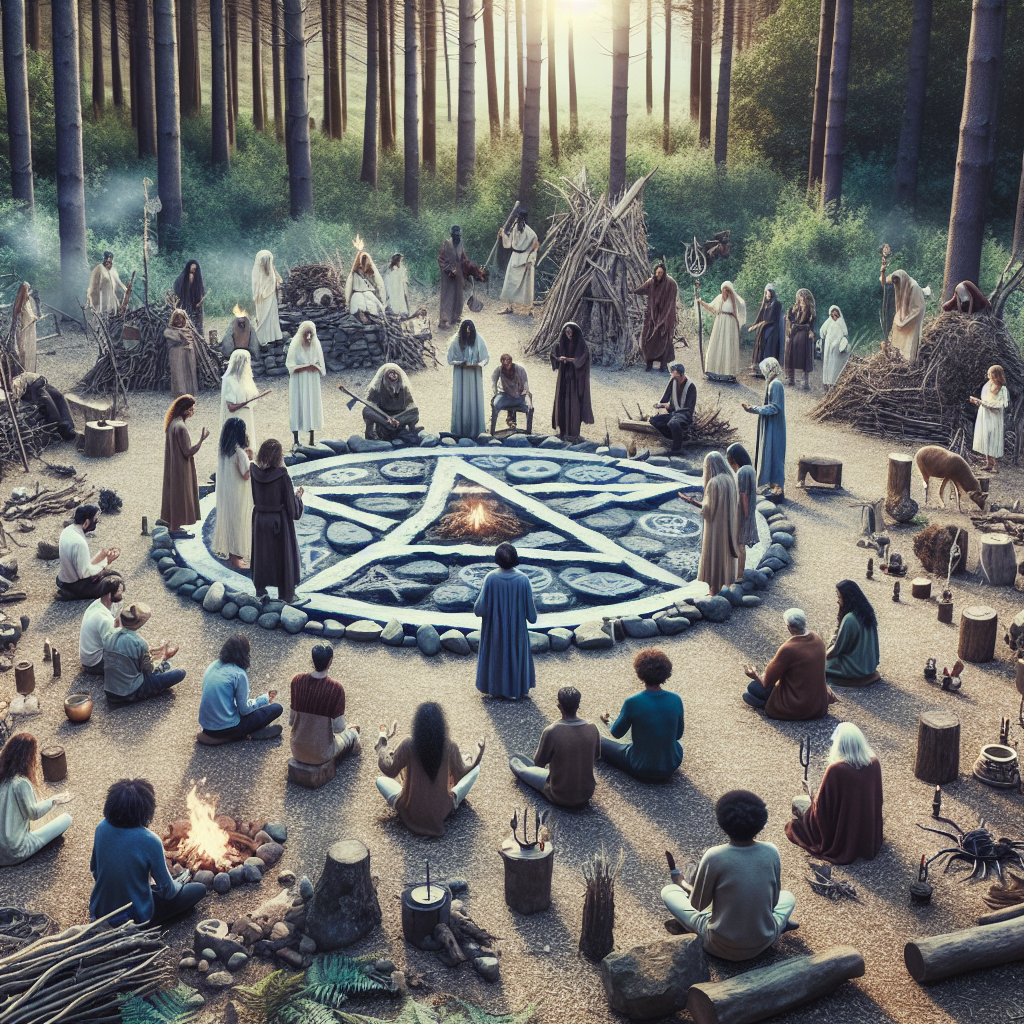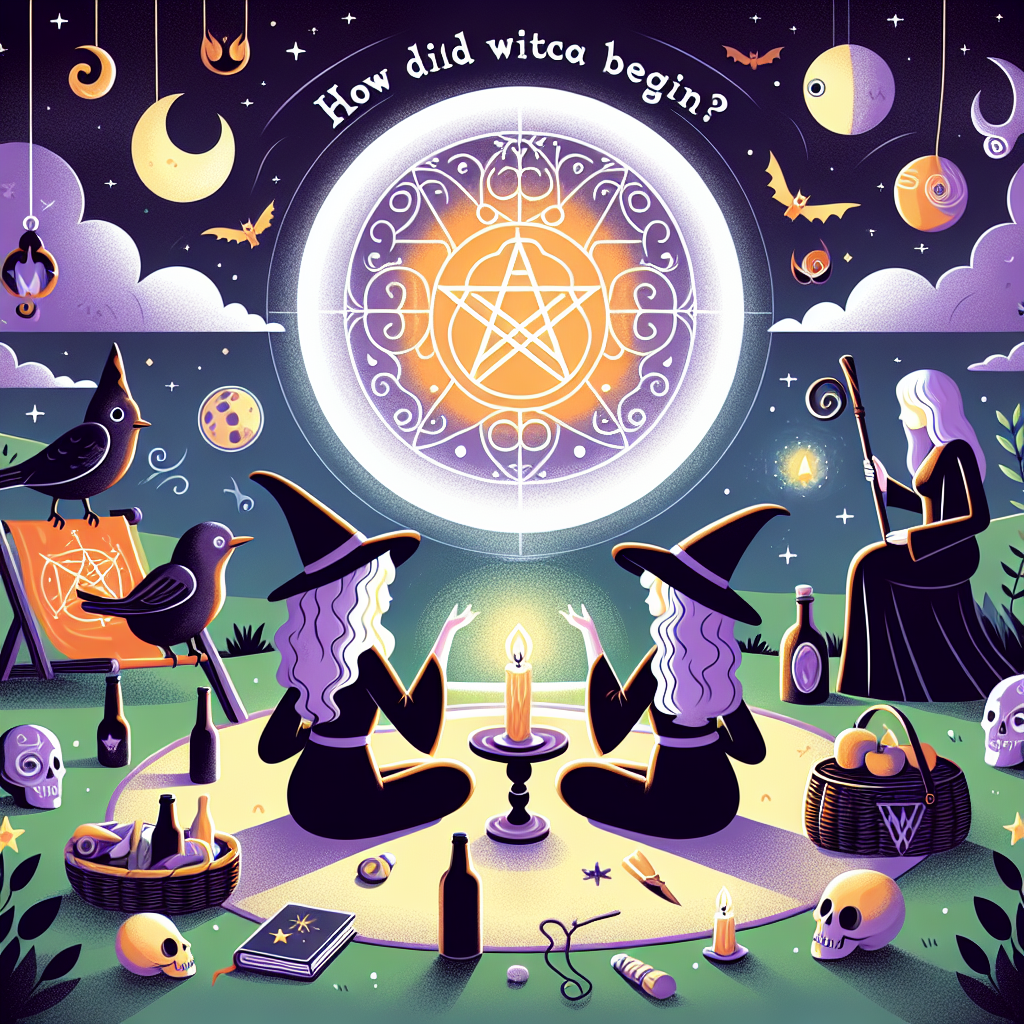As an Amazon Associate I earn from qualifying purchases.

Wicca, a modern pagan religion that celebrates nature and the seasonal cycles, emerged in the mid-20th century and has since grown to become one of the most influential and rapidly expanding religions of the modern age. Spearheaded by a charismatic and erudite Englishman named Gerald Gardner in the 1940s and 1950s, Wicca draws on a diverse array of older traditions, including folk magic, ancient pagan religions, and 19th-century esotericism.
Gardner claimed that the contemporary Wiccan practices he promoted were rooted in an ancient, pre-Christian fertility cult, which had survived in secret throughout the Christian era. He declared that he was initiated into this old tradition by a New Forest coven, and he took the responsibility of bringing this hidden religion into the public eye. His first non-fiction book on the subject, “Witchcraft Today,” published in 1954, brought the practices and philosophies of this old yet reinvigorating religion to a broader audience.
What made Wicca particularly distinctive in the religious landscape of the 20th century was its decentralized nature and the ability for practitioners, or Wiccans, to adapt and personalize their beliefs and rituals. By the 1960s and 1970s, Wicca had begun to spread beyond the UK to other English-speaking countries, especially the US and Australia, where it split into various traditions. Some followed closely with Gardner’s original teachings (known as Gardnerian Wicca), while others branched out into new directions, such as Alexandrian Wicca, founded by Alex Sanders, and Dianic Wicca, which placed a greater emphasis on the divine feminine.
Despite initial skepticism and opposition by mainstream society, especially in the heavily Christian-influenced Western cultures, Wicca’s focus on the divine in nature, its reverence for the Earth, and its honoring of both male and female deities struck a chord amidst the cultural shifts and environmental movements of the latter 20th century. The religion’s adaptability and inclusivity attracted a diverse following and catalyzed the growth of Neopaganism as a broader religious category that sought a more personal and experiential approach to spirituality.
This continued interest and expansion is reflected in compelling statistics: a 2001 American Religious Identification Survey reported the number of Wiccans in the United States to be over 134,000, with high estimates suggesting numbers well into the millions worldwide as of the 21st century. Those numbers are especially noteworthy considering Wicca’s relative newness on the religious scene and its sometimes controversial portrayal in media and popular culture.
The appeal of Wicca lies in its flexible structure, which allows practitioners to weave personal spiritual paths from a tapestry of myth, folklore, and ritual. The ecological consciousness at its core aligns well with contemporary concerns about the environment and sustainability. With seasonal holidays corresponding to the cycles of nature—like the solstices, equinoxes, and points in between, known as Sabbats—Wicca encourages its followers to live in harmony with the Earth and its rhythms.
“`html
What Are the Roots of Wicca? Exploring the Birth of Modern Paganism
“`
Wicca, often recognized as one of the key strands of contemporary Pagan religions, began in the mid-20th century—its emergence closely tied to the works of British civil servant Gerald Gardner. Rooted in pre-Christian traditions, occult practices, and the Romanticist veneration of nature, Gardner is credited with founding the religion in the 1940s and 1945 following his interactions with older esoteric groups and his own research. The formation of Wicca stemmed from a synthesis of ancient mythologies, folk practices, ceremonial magic, and Gardner’s interpretations of these elements into a new, cohesive religious framework. While it draws on various historical sources, Wicca was largely innovative, reflecting the changing spiritual landscape of the post-war era. Its core principles include the worship of a goddess and a god, the observation of nature-based festivals, and the practice of magic. As we delve deeper into the subject, we’ll unravel how these elements converged to create Wicca, how it grew to become a worldwide spiritual movement, and the ways in which it continues to evolve and diversify within contemporary spiritual milieus.
Wicca, often described as a modern pagan, witchcraft religion, emerged in the early to mid-20th century. Its origins are generally attributed to a British civil servant and amateur anthropologist named Gerald Gardner. Gerald Gardner is often hailed as the father of Wicca, for he was the first to introduce what he claimed were the practices and beliefs of an ancient pagan witch cult to the public eye.
Gardner’s interest in the occult led him to become involved in various esoteric groups. In the late 1930s, he claimed to have been initiated into a coven of witches in the New Forest region of England and spent several years immersed in their traditions, which he believed were a surviving ancient pagan religion. According to Gardner, these practices had been passed down through generations and remained hidden due to the persecution of witches throughout history.
In 1954, with the repeal of the Witchcraft Act in England, Gardner published “Witchcraft Today,” presenting Wicca to the world and claiming it as a direct continuation of the Witch-Cult hypothesized by Margaret Murray (a theory largely discredited by the academic community). Gardner’s writings detailed the Wiccan practice, rituals, and theology. Central to Wiccan belief were reverence for the Goddess and the Horned God, celebration of the cycles of the moon and sun (esbats and sabbats), ritual magic, and the Wiccan Rede “An it harm none, do what ye will.
Gardner’s Wicca was organized into covens, typically with a high priestess and priest leading rituals in a very hierarchical structure. Initiates were brought into the religion through a process of degrees, which included oaths of secrecy about the rituals and practices.
Over the years, Wiccan beliefs and practices evolved and diversified. In the 1960s and 1970s, the religion was influenced by the burgeoning New Age movement and the feminist movement, resulting in different traditions branching from Gardner’s original teachings. Notables such as Doreen Valiente, who worked with Gardner and contributed to the formation of Wiccan liturgy, and later figures like Starhawk, who infused Wiccan practices with feminist and ecological activism, were instrumental in shaping the diversity within modern Wicca.
Today, Wicca is eclectic and embraces a variety of beliefs and practices, from those strictly following Gardnerian Wicca to others that blend different pagan, shamanic, or ceremonial magic traditions. Wiccans often adapt their practices to their personal beliefs and the local culture, which has been made easier due to the absence of central religious authority.
As of the latest surveys and estimates, the practice of Wicca has seen substantial growth, especially in the United States. According to the Pew Research Center’s religious landscape study, the number of Wiccans and Pagans jumped from approx. 340,000 in 2008 to at least 1.5 million in 2014, indicating a significant increase in its followers. This statistic reflects not only the religion’s growth but also a societal shift towards more inclusive and diverse spiritual practices.
1. What is Wicca, and how is it classified as a religion?
Wicca is a modern, nature-based pagan religion that emphasizes the reverence of the Earth, the practice of magic, and the worship of a Goddess and a God. It is classified as a religion because it has a defined set of beliefs, practices, rituals, and ethical codes that its adherents follow.
2. Who founded Wicca, and when did it begin?
Wicca was founded by Gerald Gardner in the mid-20th century. Gardner introduced the modern form of Wicca to the public with the publication of his book “Witchcraft Today” in 1954, after the repeal of the Witchcraft Act in England in 1951.
3. What are some of the main beliefs of Wicca?
Main beliefs of Wicca include the worship of the Goddess and the God, the observance of the Wheel of the Year and its associated festivals, the practice of magic, and following the Wiccan Rede, which advises one to “harm none.
4. How did Gerald Gardner develop the practices and teachings of Wicca?
Gerald Gardner developed the practices and teachings of Wicca by synthesizing earlier occult and pagan sources, his experiences with various covens, and his personal beliefs. He claimed that he was initiated into a surviving tradition of English witchcraft, which he then modernized and made public.
5. What is the Book of Shadows, and what role does it play in Wicca?
The Book of Shadows is a personal grimoire used by Wiccans to record spells, rituals, and magical experiences. It is considered a sacred text and plays a central role in the practice of Wicca, serving as a guidebook and reference for the practitioner’s spiritual journey.
6. What is the significance of the pentagram in Wicca?
In Wicca, the pentagram is a symbol of protection and a representation of the five elements—earth, air, fire, water, and spirit. It is often used in ritual practice and is worn as an amulet to symbolize one’s faith in the Wiccan religion.
7. How does Wicca differ from traditional witchcraft?
Wicca differs from traditional witchcraft in that it is specifically a modern, organized religion with structured beliefs and rituals introduced by Gerald Gardner. Traditional witchcraft, on the other hand, refers to various regional and historical practices that precede Wicca and may not be organized into a cohesive religious system.
8. Can Wicca be practiced both individually and in groups?
Yes, Wicca can be practiced both individually, known as solitary practice, and in groups known as covens. Both forms of practice are considered valid and offer different benefits and experiences to practitioners.
9. Are there different “traditions” within Wicca, and what does this mean?
Yes, there are different “traditions” within Wicca, which refer to various branches that have their own specific set of practices, rituals, and teachings. Some well-known traditions include Gardnerian, Alexandrian, and Dianic Wicca. Each tradition offers a distinct interpretation of Wiccan beliefs and practices.
10. Is Wicca recognized as an official religion in various parts of the world?
Wicca is recognized as an official religion in some parts of the world, including the United States and the United Kingdom. Its recognition allows for legal rights and protections as afforded to adherents of other religions.
Conclusion
Wicca’s inception can be traced back to the early 20th century when it emerged as a disparate set of beliefs and practices that sought to reconstruct and reimagine pre-Christian, nature-based spiritual traditions. Gerald Gardner, often hailed as the father of modern Wicca, was instrumental in synthesizing these elements into a more cohesive religious system in the 1940s and 1950s. Gardner introduced the Wiccan Rede, a guideline for ethical conduct, and the concept of a duotheistic belief system that venerates a Goddess and a God. He also emphasized the importance of ritual ceremonies that align with the cycles of the moon and the solar holidays. Through his books and teachings, Gardner provided a framework upon which the foundations of modern Wicca were built.
Modern Wicca has since branched into diverse traditions, each with its own unique characteristics but all generally retaining core elements of reverence for nature, belief in the potency of magic, and celebration of seasonal festivals known as Sabbats. Despite its relatively recent origins and evolution, Wicca has established itself as a prominent religion that represents a yearning for more personal and intimate spiritual experiences in harmony with the natural world. Its growth and the proliferation of covens and solitary practitioners worldwide are testaments to its lasting appeal and the fundamental human desire for connection with something greater than oneself, as well as the power of reinventing ancient wisdom in contemporary forms.
Amazon and the Amazon logo are trademarks of Amazon.com, Inc, or its affiliates.


